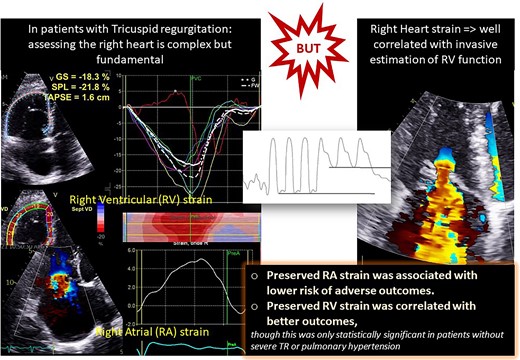-
Views
-
Cite
Cite
Elizabeth Curtis, Léo Lemarchand, K Charlotte Lee, Elena Galli, Guillaume L’Official, Vincent Auffret, Guillaume Leurent, Emmanuel Oger, Erwan Donal, Right atrial and right ventricular strain: prognostic value depends on the severity of tricuspid regurgitation, European Heart Journal - Cardiovascular Imaging, Volume 25, Issue 12, December 2024, Pages 1734–1742, https://doi.org/10.1093/ehjci/jeae182
Close - Share Icon Share
Abstract
Assessing right heart function is challenging, particularly when significant tricuspid regurgitation (TR) is present. Amongst available echocardiographic techniques for assessment, literatures suggest that strain imaging may be more reliable and less susceptible to loading conditions. Thus, we aimed to assess the validity of right atrial (RA) and right ventricular (RV) strain relative to conventional metrics as well as their utility in predicting patient outcomes in TR.
We studied 262 consecutive patients (mean age 74 ± 11.2 years, 53% male) who underwent same-day echocardiography and right heart catheterization between 2018 and 2023. We compared right heart strain to traditional metrics of RV function and subsequently correlated RA and RV strain to heart failure (HF)-related death or hospitalization, whichever came first. Over a mean follow-up of 34 ± 15 months, there were 103 deaths and HF hospitalizations. Both RA strain and RV strain were correlated with echocardiographic and invasive measures of right heart function. Across all patients, preserved RA strain was associated with lower risk of adverse outcomes [hazard ratio (HR) 0.763, 95% confidence interval (CI) 0.618–0.943]. Similarly, preserved RV strain was correlated with better outcomes, although this was only statistically significant in patients without severe TR or pulmonary hypertension (HR 2.450, 95% CI 1.244–4.825). Moreover, abnormal ratios of RV strain to pulmonary pressures and RV size were significantly correlated with adverse outcomes (P < 0.05 each).
RA and RV strain are independently correlated with echocardiographic and invasive measures of cardiac function. Moreover, preserved RA and RV strain is likely associated with better clinical outcomes.

- catheterization of right heart
- tricuspid valve insufficiency
- echocardiography
- lung
- atrium
- heart failure
- pulmonary hypertension
- follow-up
- heart ventricle
- diagnostic imaging
- pressure-physical agent
- patient prognosis
- treatment outcome
- pulmonary artery line
- cardiac function
- right side of heart
- patient-focused outcomes





